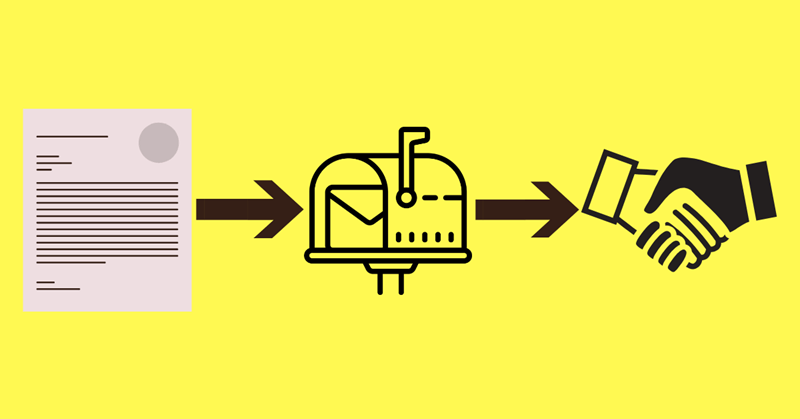
Many marketers that have a solid foundation in digital marketing channels haven’t been exposed to a fundamental component of direct marketing – the sales letter.
It’s easy to get caught up in building out automated campaigns that drive people to your website, and automated email sequences to nurture and convert them.
However, with the renaissance of direct mail well underway, many digitally oriented marketers are rethinking how to leverage the sales letter, but in new and far more efficient ways.
Build A Letter Online – No Registration Required
What Is A Sales Letter?
Think of a sales letter as powerful tool that gives you the license and real estate to truly sell. They’re a longer form piece of content designed to speak to your audience in a persuasive and meaningful way.
The best letters show your audience that you know what their problems, pains and aspirations are and that you know how to help them reach their goals.
They also make it easy to understand your offer and to take action. They help you sell.
Why Would You Automate A Sales Letter?
When you automate a powerfully written letter, you’re pouring gasoline on a fire.
Imagine replacing the old, time consuming manual process of sending direct mail letters with a new, software driven process that is like sending an email campaign.
New automation tools can scale the process of personalizing, producing & distributing these powerful marketing & sales pieces.
The Secrets Of A Great Sales Letter

Experienced direct marketers know the importance of the sales letter as a touch point in a multiple step marketing campaign.
They also focus on copywriting and really think through the psychological impact of the words they choose.
You don’t need to be a 30 year direct marketing copy pro to create a great sales letter though. Just follow the formulas that have been used by the best of the best and you’ll see great results.
Know Your Audience
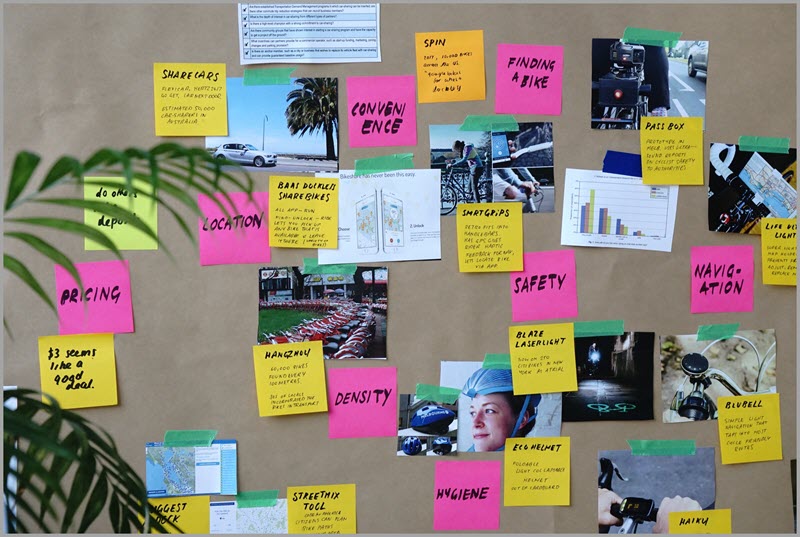
The more you understand your audience, what motivates them and what their fears and challenges are, the better your letter will be.
The good news is, many digital marketers have done a tremendous amount of research in the process of assembling buyer’s personas. Inbound and content marketing best practices start with this process of really getting into the heads of your buyers.
If you’ve done persona work, you can leverage it in your sales letter. If not, do some basic research on your target audience. The persona model is a great one to work with.
For your sales letter, try to develop an understanding of your audience that will help you to answer 3 questions:
- What are their aspirations? “I would love to plug in a new tool to get my stalled pipeline moving”
- What are their primary pain points & fears? “Direct mail sounds great, but I don’t have time for 4-6 week production cycles, and I can’t introduce another channel that doesn’t integrate with my digital marketing efforts”
- What is holding them back from getting started? “Of course I’d love to add direct mail, but I don’t know where to begin”
Obsess Over The Headline
A headline is typically the first thing that the audience will see. Just like on the web, you’ve got a split second to win over your reader. Here’s a couple of important tips:
- For top of the funnel, lead generation letters, use questions in the headline
- “Does your pipeline seem to be filled with stalled deals?”
- For lower funnel or post sales letters, get to the benefits immediately
- “Connect direct mail to your email marketing to start boosting response rates in minutes”
- Include a sub-headline to set the reader up for what’s next
- “And do it without getting locked into expensive contracts”
Headlines telegraph a clear reason to continue reading. They set the tone for the entire letter.
Take a look at this great example from renowned copywriter Bob Bly:

Customer Stories Sell: Write A Story With At Least 3 Hooks
Digital marketers understand the power of social proof and case studies. Customer stories are a mashup of these proven techniques that work great in a letter format. The best stories include at least 3 hooks that resonate with your audience.
What’s a hook? It’s a part of your copy that creates an underlying emotional theme for you to build upon. The letter gives you real estate to create emotional reasons to act. Hooks are your framework for action.

How do you write these powerful hooks? Go back to your research & rough out a thumbnail sketch of at least 3 hooks that tie into your audience with any of the following techniques:
- Illustrate Their Aspirations – show them how you’ll help them reach their aspirations: “You can start moving deals through the pipeline faster & easier”
- Thought Leaders Use It – leverage the digital marketing notion of “social proof” to show that similar consumers or businesses love the product or service.
- Dig Into Their Pain – really expose their fears: “Why can’t I ever improve my conversion rate?
- The Big Revelation – a single ideas that gets around barriers or uncertainties: “I realized that direct mail can be as easy to automate as email”
- Tough Love – what happens if you don’t take action? “If you want to keep looking like every one of your competitors, just keep sending more email”
- The Big Win – tell a story of a persona member winning with your solution: “Marketing manager doubles SQL development in 2 months with automated drip sales letters”

When you’ve written out your hooks, weave them together with a story that has a classic story arc. A story arc is the sequence of events in your story:
- A protagonist that your audience identifies with, and background about their problem – or the seeds of their conflict.
- How your protagonist grows & changes their thinking due to the conflict or problem. Ideally it reaches a climax.
- How they solve their problem and the results.
Draw Skimmers In With Three Bullet Points And A Call Out
It’s important to remember than many of your recipients are skimmers. They’ll quickly glance at your letter, and if they don’t immediately see something of value, they’ll toss it.
However, if your copy and design does grab them, they’ll read most of your letter. That’s why it is important to use bullet points and a shaded call out to showcase the most important benefits that you offer.

Neuromarketing experts agree that consumers are able to process information in groups of three better than other numeric groupings. That’s why you’ll hear references to “3 step plans” from your favorite politicians or “3 easy steps” from marketers everywhere.
Why fight the power of 3? We recommend capturing the attention of sales letter skimmers by picking the 3 top benefits of your product or service and laying them out in bullet points or in a shaded callout box or a Johnson Box.
What’s A Johnson Box?
The Johnson Box is a classic direct mail technique that experienced marketers have long relied upon to draw attention to key benefits. It is a box commonly found at the top of direct mail letters.
The Johnson Box typically contains the key benefits or message that you would like your audience to understand, grabbing the reader’s attention before diving into the details in the letter itself.
Here’s an example of a Johnson Box from an AAA mailing:

Take note of how the first two lines let the reader know that they are already “approved” for AAA’s main benefit — 24/7 roadside assistance in any car. Headlines and Johnson Boxes are an effective way to dial in the attention of your readers and have them enter your personalized sales letter actively engaged.
Be A Closer With A Strong Offer
The offer is the pièce de résistance of your sales letter. You’ve educated and persuaded the audience, now it is time to bring it all together.
Explain your offer. Tell them exactly what they’re getting, how the offer works and how to get it.
It is very important that your offer is clear. The most effective way to do this is to build around a strong call to action.
Call To Action With Clarity
The call to action should be the focal point of your letter. Your audience needs to know what steps they need to take to take advantage of your offer, whether that is visiting your website (like through Postalytics’ personalized URL system), giving you a call, sending you an email, mailing you back a request, or connecting with you on social media.

Your call to action gives them the directions that they need to take the next step and is the most critical component of an effective sales letter. If they don’t have clear directions, they won’t become your customer!
Build A Sales Letter Template – No Registration Required
Automated Sales Letters – New Tech For A Classic Technique
The sales letter has been a reliable tool to generate leads and sales for decades. However, the production, tracking and integration of the sales letter with other digital and email marketing tools has lagged behind. Direct mail production has largely remained an offline process, and it hasn’t been integrated into the digital marketing tech stack like so many other channels have.
Tech is now coming into the direct mail marketing world, and it is revolutionizing the way that marketers can deploy classic, high performing direct mail pieces. Direct mail automation services like Postalytics streamline, track and integrate sales letters so that they’re as easy as email to deploy. The relative ease of reaching customers through the use of these tools is generating a renaissance in direct mail as a result.
Here’s some of the ways that automated direct mail marketing is revitalizing the sales letter.
Sales Letter Templates – Just Like Email Templates
When you use Postalytics, you can build a sales letter template in the letter editor. Your sales letter template becomes a re-usable asset stored in a template library that you can deploy over an unlimited number of campaigns. You can even click to make a copy of your initial template and simply edit to develop an entirely new letter.
The letter editor gives you the option to choose from pre-defined templates as a starting point, or lets you just build from scratch using the drag & drop editing functions. You can build a letter template in minutes, with up to 12 pages printed on both sides of a sheet of paper.
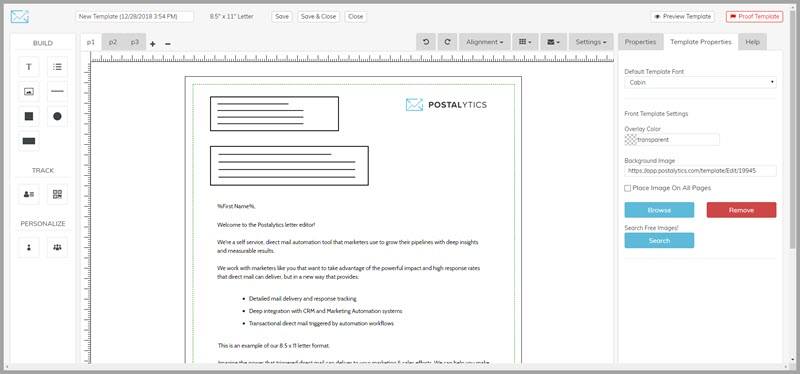
Would you like to play around with a letter template? We’ve made a version of the letter editor available with no registration required:
Learn About Postalytics Direct Mail Letter Campaigns
The Power Of Personalization
The reason why sales letters are so effective is because they seem so personal. A great sales letter feels as if it was written specifically for the recipient and should include data and details that help to reinforce that feeling.
Having their name in the salutation is a good start, but being able to reference a reason why they would be interested in your offer (the company they work for or own, their position or role in an organization, their interest in similar products) can really take your ROI to the next level.
Direct mailers have used a technique called “Variable Data Printing” for years to introduce personalization into sales letters. Direct mail automation tools are able to do this right within the templates that are used to generate campaigns.
Here’s an example of the Postalytics Variable Data feature in the Postalytics Editor:

Take your time to find opportunities to implement deep personalization in any sales letter that you send. Using Postalytics, you can import any data that you have on hand to personalize your direct mail sales letters and allow prospects to feel like you are speaking to them personally.
Postalytics has a free tool called “Variable Logic” that empowers you to incorporate dynamic content with an easy to use editor:

CRM or Marketing Automation Triggered Drip Sales Letters
Sales letters were traditionally produced in 2 different ways: By hand (mail merge, folding, stuffing, addressing, postage, drop off at post office) or by a direct mail agency or print service provider. Neither method is very efficient, and neither method lends itself to integration with core systems that are driving so much in marketing today, the CRM and/or the Marketing Automation Platform.
Now, automated integrations and letter API’s make the sales letter a marketing piece that can be triggered on a piece by piece basis as prospects or customers move the buyer’s journey. Automated workflows can send Postalytics the contact and personalization data for any lead or contact and automatically trigger a sales letter to go out at the exact stage of the journey that you desire.
As you can imagine, marketers are eating this up. Sales letters and postcards are now being mailed 24 x 7 x 365 as customers move through their journeys. The sales letter is now being used to complement email marketing, with cadences sending both email and direct mail coming into vogue.
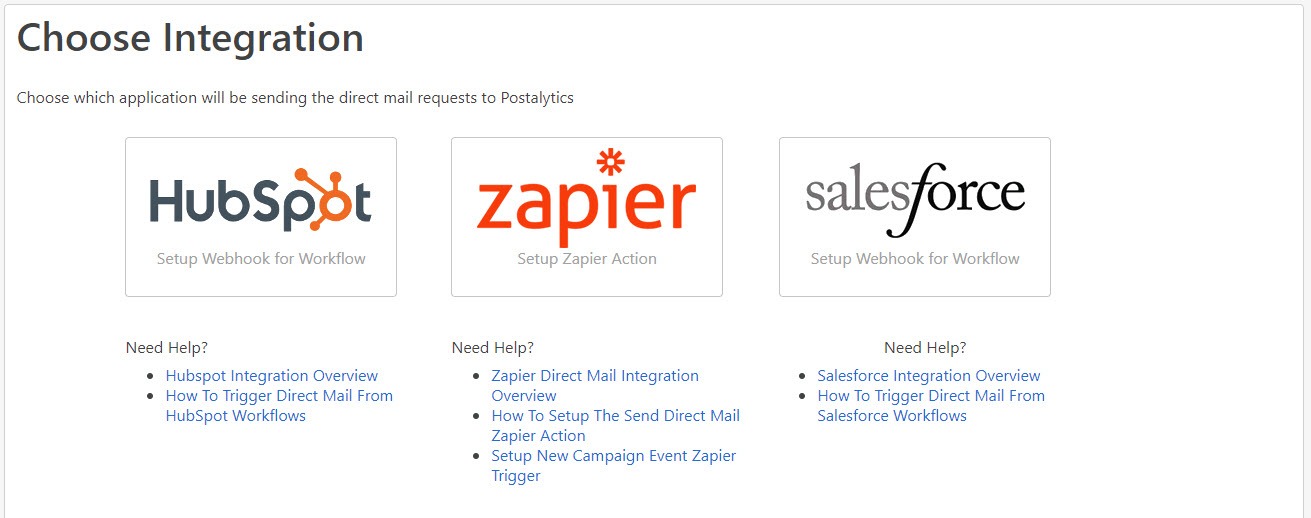
Automated Tracking Of Letter Delivery And Response
While direct mail has always been considered an effective channel, the manner by which it has been tracked by all but the largest mailers has been limited.
Often, we hear from established mailers “I know that direct mail works, because sales decrease when I stop mailing”. Not the most scientific marketing process you can imagine.
Direct mail automation tools give the measurement and tracking tools that the largest direct mailers have had access to to smaller less experienced marketers.
Postalytics uses the USPS Intelligent Mail Barcode tools to track the delivery and returns for sales letters. We also also offer pURLs to track the online response to each piece of mail sent.
Dashboards are updated in real time as delivery and response data flows in. Just like it does with digital campaigns. We can even sync delivery and response data to CRM tools for reporting and triggering of next steps in automated workflows.
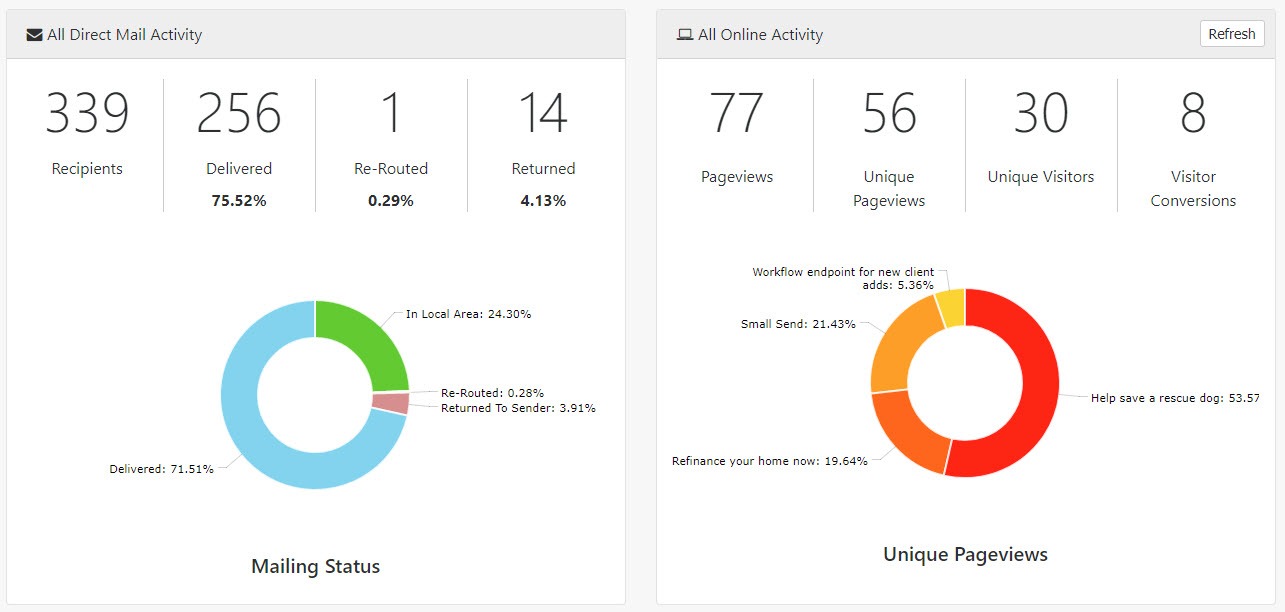
These are just a few of the advantages that direct mail automation tools like Postalytics bring to the table. It really is a no-brainer to build your sales letter in tools like these.
Learn how direct mail response rates are tabulated.
Here’s some other tips and tricks that can make your sales letter a high performer.
How Long Should A Sales Letter Be?
The length of your letter should be determined by the complexity of the product or service you’re selling.
Don’t get caught up in formulas that tell you exactly how long they should be. The letter should be long enough to concisely execute the important elements described above. Not more, not less.
A mantra to keep in mind – “Long Copy Is OK. Long-winded Copy Is Not OK”.
Good automation tools have multiple page features that let you fully explain the benefits of complex products and services.
Be Conversational
Remember — you want your prospect to feel like they are being spoken to directly. For that reason, you should aim to create sales letters that are conversational in tone. If they come across as “overly-salesy” or read more like other types of marketing collateral, you’re going to have a hard time getting the prospect to truly connect with what you have to say in the letter. Speak to their biggest issues and concerns as they relate to your product.
FAQ’s Work Really Well
Just about every product website has a Frequently Asked Questions section. Why not include a page devoted to FAQ’s around your offer?

When you include FAQ’s in your sales letter, you’re showing that you really know your stuff, and that you’ve thought of just about every objection that the audience can throw at you.
Use a P.S. Effectively

A postscript at the bottom of your direct mail sales letter can be a helpful tool. It is one of the most-read parts of any sales letter and should deliver a clear, important message to your audience. A few of the different approaches that you can take for an effective sales letter postscript include:
- Restate your offer
- Remind your prospect of a deadline
- An added-value offer to sweeten the pot
- A reminder of your call to action
In many ways, your P.S. is a headline at the end of your sales letter. It should typically be no more than three lines long. Ideally, you would keep it to a single line.
A More Personal Format
Sales letters are simply a more personal way to connect with your customers through direct mail. They allow you to speak directly to your audience, addressing their biggest needs and concerns in a way that pertains to their specific situation.
Using Postalytics to create and deliver direct mail sales letters gives the power of a one-on-one conversation at scale.
If you’d like to see how Postalytics can help your company leverage direct mail in a new, smart way:
About the Author

Dennis Kelly
Dennis Kelly is CEO and co-founder of Postalytics, the leading direct mail automation platform for marketers to build, deploy and manage direct mail marketing campaigns. Postalytics is Dennis’ 6th startup. He has been involved in starting and growing early-stage technology ventures for over 30 years and has held senior management roles at a diverse set of large technology firms including Computer Associates, Palm Inc. and Achieve Healthcare Information Systems.
